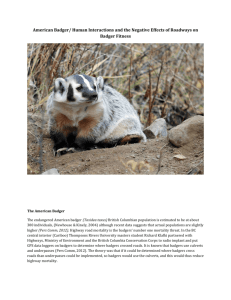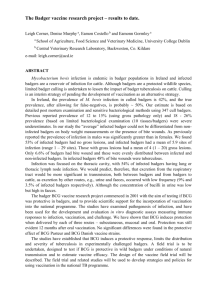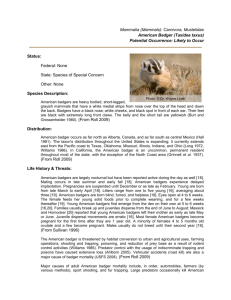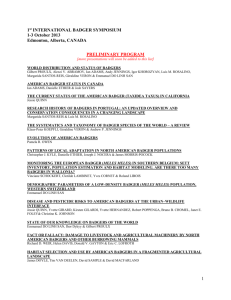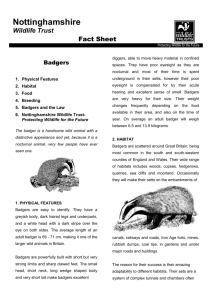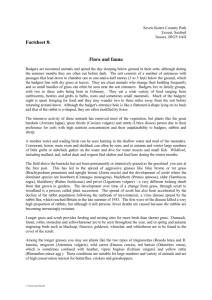Document 11289897
advertisement
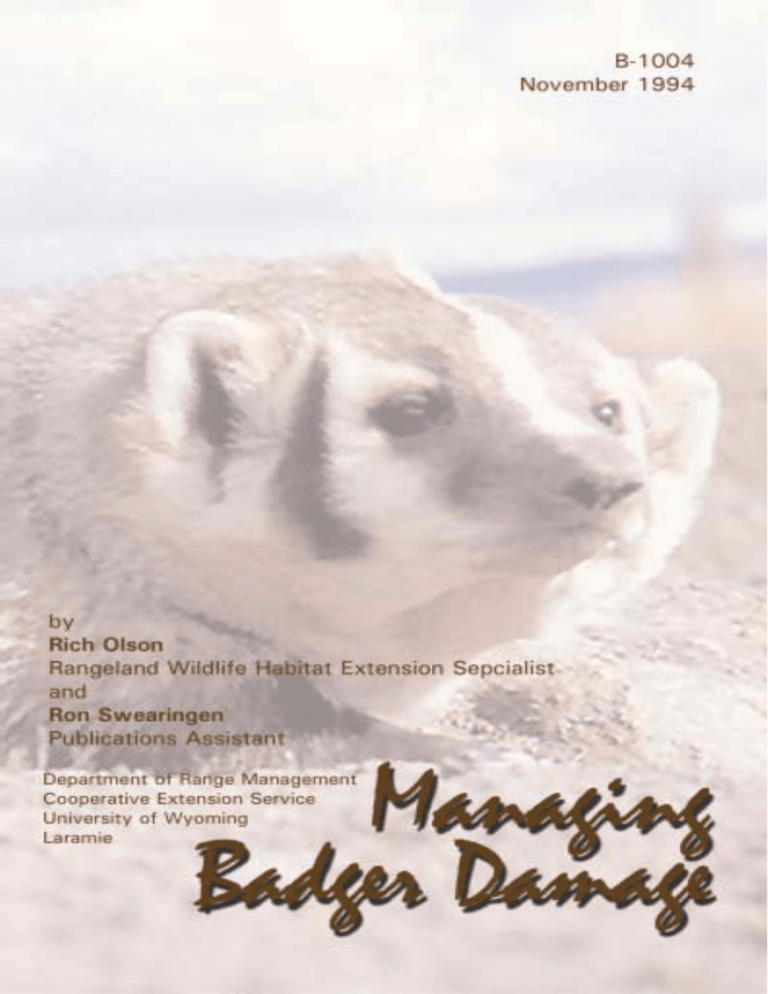
Summary of Damage Prevention and Control Methods: Exclusion: Generally not effective Habitat Modification: Controlling small mammal populations reduces prey base, making habitats less attractive for badgers Frightening: Bright lights may discourage nocturnally active badgers Repellents: None registered for badgers Toxicants: None registered for badgers Fumigants: None registered for badgers Traps: Steel leg-hold traps and live traps are effective for licensed trappers during regulated trapping seasons and for individual animals causing damage on private property. Shooting: Where damage occurs on private property, shooting by the landowner, employee of the landowner, or lessee of the property is effective on the damagecausing individual animal. Cover photo courtesy of Fred G. Lindzey, assistant unit leader, National Biological Survey, Wyoming Cooperative Fish and Wildlife Research Unit, Laramie. Managing Badger Damage By Rich Olson Rangeland Wildlife Habitat Extension Specialist Department of Range Management Ron Swearingen Publications Assistant B-1004 November 1994 Department of Range Management Cooperative Extension Service University of Wyoming Laramie Introduction American badgers (Taxidea taxus) can be an asset or a liability depending on their compatibility with human interests and activities in a particular situation. The holes they dig are hazardous to livestock and people. In agricultural areas, digging can result in economic losses due to crop and machinery damage. However, badgers also provide beneficial effects by preying on rodents that may cause cropland and rangeland damage at high population levels. Managing badgers must be considered from a site-specific context. Total eradication of badgers is not a desirable management approach. However, where conflict occurs with agricultural production or human activity, selective damage management techniques can be employed to reduce economic losses and hazards to humans. This publication describes the general biology of American badgers in Wyoming and provides suggestions for managing badger damage where problems occur. Species Description Badgers are heavy, flat-bodied, medium-sized mammals with short, strong legs; a thick, short neck; a broad head, and a short, bushy tail. This yellowish-gray mammal has a median white stripe from its nose over the top of its head, white cheeks, a black muzzle, a black spot in front of each ear, and black feet with extremely long front claws. Long guard hairs are black tinged. Badgers can weigh up to 30 pounds although average weights are 19 pounds for males and 14 pounds for females. Badgers have specialized anatomical features adapted for burrowing into soil. Their ears are round and covered with stiff bristles for protection from the soil when digging. Their eyes have a well-developed clear protective membrane called a nictitating membrane that covers and cleans the entire eye surface. The front feet are partially webbed, which keeps the toes close together for effective digging. Long, powerful claws on the fore feet grow faster than the smaller claws on the rear feet to compensate for greater wear. A badger can dig faster than a person using a shovel, throwing dirt 4 to 5 feet in the air when digging at a vigorous pace. 1 Distribution Badgers are found throughout Wyoming and across most of the central and western United States and Mexico. However, they are absent in the Pacific Northwest states in an area west of the Cascade mountain range. They have been found at elevations up to 12,000 feet on sites with relatively deep soils. Habitat Requirements In Wyoming, grassland and sagebrush areas are commonly occupied by badgers. Treeless pastures and rangeland areas with light to moderate cover that support burrowing rodent populations are ideal for badgers. They have also been found in farmlands, marshy areas, deciduous woodlands, deserts, and tundra areas. Food Habits Badgers are mainly carnivorous, preying primarily on prairie dogs, pocket gophers, ground squirrels, and other small mammals. Studies indicate that an average badger must eat 1½ to 2½ ground squirrels or pocket gophers daily to maintain body weight. Other prey in the diet includes rabbits, hares, chipmunks, marmots, squirrels, mice, voles, rats, coyotes, and skunks. Most of the prey animals are caught below ground through rapid digging. Insects including crickets, grasshoppers, ground beetles, dung beetles, and caterpillars form a significant part of a badger’s diet in the summer. When preferred prey is scarce, badgers will eat rattlesnakes, garter snakes, lizards, frogs, and toads. Some researchers report badgers feeding on wasps and hornets, ground-nesting birds, small lambs, and half-grown domestic turkeys. General Biology Badgers spend most of their time resting and raising their young in dens. Typical dens are shallow, excavated areas with an entrance about 1 foot in diameter. A deeper burrow (5 to 30 feet long) is constructed during the breeding season and leads to an enlarged chamber 2 to 3 feet below the surface where young are raised. This chamber is usually lined with grass. Primary dens usually have a single entrance marked by a mound of dirt in front. 2 Badgers spend time resting and raising young in shallow dens characterized by oval-shaped openings with mounds of dirt at the entrances. The presence of dens and holes dug in search of prey is also a good indicator of potential badger damage problems. (Photo courtesy of Lyle Crosby, USDA-APHIS, Animal Damage Control, Casper) Mature badgers are mainly nocturnal but may be active during all hours of the day. Young badgers are mostly active during daylight hours. Badgers do not hibernate but may remain inactive in dens during periods of cold weather and low prey availability. During extreme cold periods, badgers can remain inactive for more than a month. Mating occurs in late July and August. Males are solitary except during the breeding period. Females are usually solitary except when mating or raising young. Researchers report that males will mate with any females within their home-range territory. Some yearling females breed, but males will not breed until reaching age 2. Badgers have a unique gestation cycle or pregnancy period. Following breeding in late summer, the fertilized ova (eggs) do not start developing until they become attached to the uterus. This attachment or implantation occurs about six months after mating. This process, called delayed implantation, usually occurs in February. Young are born in March or early April following a six-week gestation period. 3 Litter size averages two or three, but up to five pups may be born. Newborn badgers are blind and covered with short, soft, silky hair. Their eyes open four to six weeks after birth. Adult female badgers nurse their young for six to eight weeks. The young disperse soon after weaning although some may remain with the female until midsummer. Young badgers are playful but will return quickly to the den if disturbed. Badgers have a ferocious behavior when confronted, often hissing, growling, or snarling. Their bites are strong and capable of inflicting serious damage. There is no evidence of territorial behavior, but occasional fights between males may occur over eligible females during the breeding season. The average density of badgers is about one per square mile. However, densities ranging from five to 15 per square mile have been observed. The home range of an adult badger is approximately 2½ square miles. The highest mortality rate of badgers occurs during the first two years of life, primarily from predation. Major predators of badgers are mountain lions, bobcats, eagles, and coyotes, although coyotes have been observed hunting together with badgers. Badgers have the potential to live a long time. Longevity records of badgers have been documented at 14 years for wild animals and 26 years in captivity at the San Diego Zoo. Economic Impacts Badger damage is generally more localized than widespread, and there is no specific data available summarizing badger-caused economic loss. Damage to livestock or poultry is probably limited to areas with relatively low rodent populations. Damage to roads from digging, however, is more extensive and costly in areas with high population of small mammals. From a site-specific standpoint, badger damage to crops, livestock, and poultry can be potentially extensive for some individual agricultural producers. Income generated from badger pelts varies annually in Wyoming. Badger pelts have been used for trimming jackets and coats. At one time, badger hair was used in manufacturing shaving brushes. Euro- 4 pean badgers, in particular, were preferred for brush production. According to Wyoming Game and Fish Department estimates, badger harvests average 2,000 pelts each year, generating total revenue of approximately $40,000. Legal Status In Wyoming, badgers are classified as fur-bearing animals, and licensed trappers may take badgers during regulated trapping seasons. Indiscriminate trapping or shooting of badgers outside of established trapping seasons or by unlicensed trappers is prohibited. However, badgers that damage turf areas, agricultural fields, irrigation systems, reservoirs, and other areas of privately owned land may be killed immediately by the landowner, an employee of the landowner, or a lessee of the property. For information on obtaining a trapping permit, contact a local Wyoming Game and Fish Department office. Damage Problems and Identification Damage from badgers is most often associated with holes left by digging. Holes and burrows are a hazard for livestock, horseback riders, vehicles, and other people. Holes and burrows in crop fields can damage machinery, slow harvesting activities, and reduce yields. Badgers also damage earthen dams and dikes. A single badger can dig as many as 10 dens per square mile. Badgers also prey on young livestock or poultry by burrowing under fences or through the floors of poultry houses. European badgers have been known to kill dogs used in fox hunting and to cause considerable damage to crops. In contrast to American badgers, European badgers consume much more vegetative material in their diets. Because badger tracks are very similar to coyote tracks, proper identification of the appropriate predator is very difficult, especially for the novice. Therefore, the extent of badger damage to crops, livestock, and poultry in Wyoming may be underestimated. The best evidence of badger damage is the presence of tracks, dens, and/or holes dug in search of prey. Characteristic burrows or holes dug by badgers are oval-shaped with a wider-than-high entrance opening. Also, badgers will consume all of their prey except for the head and fur along the back. 5 Damage Prevention and Control Techniques Because of the localized nature of badger damage and difficulty in positively identifying widespread badger predation and accurately assessing economic loss, little information exists on damage prevention and control techniques. However, there are three non-lethal methods (exclusion, habitat modification, and frightening) and two lethal techniques (trapping and shooting) to employ to alleviate damage problems. Currently, there are no chemical repellants, toxicants, or fumigants specifically registered for use on badgers. Exclusion Methods Generally, fences or other exclusion devices are not very effective for excluding badgers because of the animals’ adeptness at digging. However, for small areas, heavy chain-link fencing installed approximately 5 feet below the soil surface may provide some protection against badger damage. This method could be used to protect poultry in small pens or houses. The costs of this protective technique are relatively high and must be weighed against anticipated benefits. Habitat Modification Badger densities generally correspond to the density of small mammal populations used as prey. In areas with high badger densities, a control program that reduces small mammal populations may help in reducing badger populations and corresponding damage. This non-lethal technique may be quite cost-effective for agricultural cropland areas. For example, controlling the number of ground squirrels or pocket gophers in alfalfa or grain crops will force badgers to search other areas for adequate prey, thus reducing the amount of damage they cause due to digging. In areas of high badger densities, agricultural producers may realize substantial increases in economic gains from increased crop yields after initiating a smallmammal control program. Frightening Devices Because badgers are most active throughout the night, bright lights erected in small problem areas may be a deterrent to badger activity. High-intensity lamps or floodlights used to illuminate a farmyard or 6 Prairie dogs, above, are a primary food source for badgers along with pocket gophers, ground squirrels, and other small mammals. A promising non-lethal damage prevention and control strategy is to implement a small-mammal control program in areas of high badger densities to encourage badgers to search other areas for adequate prey. This technique may be cost effective in agricultural cropland areas where badger digging reduces crop yields. (Photo courtesy of Lyle Crosby, USDA-APHIS, Animal Damage Control, Casper) poultry pen, for example, may be effective in reducing badger predation. Trapping Problem badgers can be effectively removed with live traps and/or leg-hold traps by licensed trappers during the regulated trapping season or when damage to private property occurs. Badgers are relatively easy to trap using No. 3 or 4 leg-hold traps. A common trap set is to place a dead chicken well within a recently dug burrow, protected by a leg-hold trap near the entrance. Even though badgers dig numerous fresh dens, they often return to previously excavated dens. Trap sets should be established in the same manner used in trapping coyotes, with one exception. Rather than staking a leg-hold trap to the ground, attach the trap to the center of a strong tree limb or similar heavy drag object that is at least 3 to 4 feet long. This prevents a trapped badger from pulling the ground stake loose and dragging the trap into a burrow. 7 Problem badgers can be effectively removed by using No. 3 or 4 leg-hold traps similar to coyote trap sets, with one exception. Rather than staking a leg-hold trap to the ground, attach it to a 3- to 4-foot tree limb. The tree limb will prevent a badger from pulling the trap and dragging it into a burrow. (Photo courtesy of Lyle Crosby, USDA-APHIS, Animal Damage Control, Casper) Trapped badgers, in an effort to get away, often dig in a circle around the trap anchoring point at a distance equal to the trap chain length. If using a ground stake, this digging and pulling effect in a complete circle around the ground stake could loosen the stake, resulting in a freed badger. Attaching the trap to a heavy tree limb prevents the badger from pulling the trap and dragging it into a burrow. Shooting When damage occurs to localized areas on private property, shooting is more commonly used than trapping to alleviate damage problems. This is effective for eliminating individual problem animals. Badgers commonly leave their burrows at dusk during the summer months to search for food. Landowners will frequently wait in a concealed location near the damaged area and shoot the offending creature as it leaves its burrow. Early morning hours are also a good time to shoot a problem animal returning to its burrow. 8 Summary Badgers play a key role in the ecosystem food chain by preying on potentially damaging rodent populations that could threaten agricultural cropland and rangeland at high population densities. However, badgers can also be a liability when conflicts with agricultural production or human activity occur. Most badger damage results from holes and burrows left by their digging activities. These are hazardous to livestock and humans and are economically significant to agricultural production. Some badger predation is directly targeted to livestock and poultry. Managing badger damage must be implemented on a site-specific basis because damage is often localized and related to the abundance of small-mammal prey species in an area. Because badgers in Wyoming are classified as furbearers, lethal control techniques are only appropriate during regulated trapping seasons or for individual animals causing damage on private property. Both trapping and shooting can be used as an effective management option to eliminate problem animals. Other non-lethal prevention and control techniques such as modifying habitat by reducing small mammal prey species and using highintensity bright lights to frighten badgers may be effective in certain situations. These methods, although not 100 percent effective, can be used as alternative approaches to reduce badger damage. For more information on managing badger damage, contact a local University of Wyoming Cooperative Extension Service office or a Wyoming Game and Fish Department district office or write to U. S. Department of Agriculture, Animal Damage Control, P. O. Box 59, Casper, WY 82602. 9 Information presented in this bulletin was extracted primarily from the following references: Burt, W. H., and R. P. Gossenheider. 1964. “Badger.” The Peterson Field Guide Series: A Field Guide to the Mammals, Second Edition, Houghton Mifflin Co., Boston: 67. Crowe, D. M. 1986. “Badger.” Furbearers in Wyoming, Wyoming Game and Fish Department, Cheyenne: 54-56. Johnson, N. C. 1983. “Badgers.” Prevention and Control of Wildlife Damage, edited by R. M. Timm, Great Plains Agricultural Council, Wildlife Resources Committee and Nebraska Cooperative Extension Service, University of Nebraska, Lincoln: C-1 to C-3. Krunk, H. 1989. The Social Badger: Ecology and Behavior of a Group-Living Carnivore (Meles meles). Oxford University Press, New York, N.Y. Lindzey, F. G. 1982. “Badger (Taxidea taxus).” Wild Mammals of North America: Biology, Management, and Economics, edited by J. A. Chapman and G. A. Feldhamer, John Hopkins University Press, Baltimore: 653-663. Long, C. A., and C. A. Killingley. 1983. The Badgers of the World. Charles C. Thomas Co., Springfield, Illinois. Neal, E. G. 1986. The Natural History of Badgers. Facts on File, Inc. New York, N. Y. Wyoming Game and Fish Department. 1992. Laws: Statute 23-3115. Wyoming Game and Fish Department, Cheyenne. Wyoming Game and Fish Department. 1992. Wyoming Bird and Mammal Atlas. Wyoming Game and Fish Department, Cheyenne. 10 Special thanks and appreciation are extended to Fred G. Lindzey, assistant unit leader, National Biological Survey, Wyoming Cooperative Fish and Wildlife Research Unit, Laramie; Lyle Crosby and Bill Rightmire, USDA-APHIS, Animal Damage Control, Casper; and Jeffrey S. Green, assistant regional director, USDA-APHIS, Animal Damage Control, Lakewood, Colorado, for their additional contributions of information, time-consuming review, and helpful suggestions to improve this publication. Sincere gratitude is extended to Randy Anderson, extension communications director, Ag Information, College of Agriculture, for providing an attractive layout format for this publication. Issued in furtherance of cooperative extension work, acts of May 8 and June 30, 1914, in cooperation with the U.S. Department of Agriculture, Jim DeBree, Director, Cooperative Extension Service, University of Wyoming, Laramie, Wyoming 82071. Persons seeking admission, employment, or access to programs of the University of Wyoming shall be considered without regard to race, color, religion, sex, national origin, disability, age, political belief, veteran status, sexual orientation, and marital or familial status. Persons with disabilities who require alternative means for communication or program information (Braille, large print, audiotape, etc.) should contact their local UW CES office. To file a complaint, write to the UW Employment Practices/Affirmative Action Office, University of Wyoming, P.O. Box 3354, Laramie, WY 82071-3354. 10-94/1.5M

